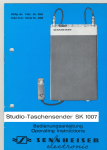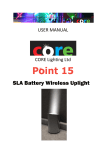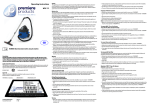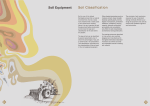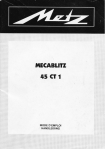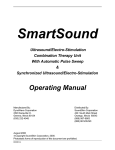Download SEAFARER 3 - 4 I NSTALLATION AND OPERATING INSTRUCTIONS
Transcript
SEAFARER 3 - 4 I NSTALLATION AND OPERATING INSTRUCTIONS TRANSDUCER INSTALLATION. WARNING:-The co-axial cable is sealed into the stem of the transducer and if damaged in any way cannot be reconnected. Do not shorten or cut the transducer lead (nominal length 24 feet or 7.3 metres) or extend it by means of co-axial plugs or any other method. Any excess cable should be coiled away from excessive heat and interference from engines or generators. Transducers with longer cable can be supplied to special order. For full depth performance the transducer stem should be mounted as near to 90' from the horizontal as possible. Install the transducer in a part of the hull which is as clear as. possible from aerated or turbulent water and where accidental damage is unlikely to occur. Normally a position slightly aft of amidships is preferable. For fin-keel sailing boats it may be preferable to fully recess the transducer into the stem so that the face is completely flush. It should be remembered that the angle of sound wave radiation is 45' and so care should be taken that a false echo is not created by one of the fin keels. If a single transducer is installed on the centre line of a boat, depth readings will be obtained up to a heel angle of 22#°. If two transducers are required, to avoid fin-keels for instance, then each should be fitted in opposite bilges facing outward at an angle of approximately 15°. By using an automatic change-over switch, readily available from the manufactures, a twin transducer installation will enable the Seafarer 3 to give accurate depth readings to heel angle of 37}°. The following illustration indicates typical transducer installations using a wooden fairing block outside the hull that has been carefully bored, carved and sanded to a streamline shape thus avoiding the creation of turbulent water which may reduce or even prevent depth i ndication when under way. In one of the examples shown, an internal fairing block has been used for strength, sealing and to allow for hull curvature. The installation should he carefully rendered watertight by using a sealing compound between all mating surfaces. Do not overtighten the nuts on the transducer stem. Do Not Shorten Cable Length Water Line Stem Fitting Not to Scale . Bilge Mounting Transducer Head Embedded in Mastic Sealing Compound Level Fitting to Avoid Water Turbulence " 1 d [lia. --S mm. The water exposed face of the transducer may be painted with one thin coat of hard racing copper, carefully applied so that the paint does not form or trap air bubbles. Take care not to damage the transducer face or the lead zirconate crystal that it protects. Accidental damage to this sealed unit cannot be repaired. Within hull transducer installation. As an alternative to mounting the transducer with the face in direct contact with water, it may be mounted within a glassfibre hull. If this method is chosen it must be accepted that there will be some reduction in the depth reading capability of the instrument, dependant upon the quality and thickness of the hull. In the United Kingdom the following parts are readily available from Builders merchants, Chandlers and model shops. (Alternatively a complete kit of parts, excluding the transducer, may be obtained from Electronic Laboratories (Marine) Ltd. or from one of their stockists). Parts required. Note: It is important that transducer housing tube be made from ABS material and not Polypropylene or Polythene. (1) Quantity 1, tube type Z.74 If" 1 /D x Ift. long. (Made by Osma Plastics under the trade name "Osmaweld"). (2) Quantity 1, socket Z.104 12" I /D. (Made by Osma Plastics under the trade name "Osmaweld"). (3) Quantity 1, socket plug Z.296 1;" 1/D. (Made by Osma Plastics under the trade name "Osmaweld"). (4) Quantity 1, tube of polystyrene cement. (As used in the construction of model kits). (5) Quantity 1, -} pint castor oil. (6) Quantity 1, medium size glassfibre repair kit (obtainable from garages or chandlers). Method of installation. (1) with the boat in 20-30 feet of water, determine a position from inside the hull, ideally slightly aft of amidships, where the Seafarer gives a reading of the correct depth with the transducer face pushed hard against the inside of the hull and the gain control turned to maximum (it will be necessary to wet the face of the transducer with water during this test to provide a good interface between the transducer and the hull). The transducer should be as near vertical as possible during this test. Operate the engine(s) during the test to see that there is no electrical interference, keeping the co-axial transducer cable away from the engine(s). If minimal or no interference is recorded by the Seafarer, mark the chosen transducer position inside the hull after making sure that it is free of water, grease and oil. (2) Cut the 12" 1/D tube to about 4" long. Again cut the tube, without decreasing the overall length of 4", to such an angle that it matches the inside curvature of the hull when positioned vertically. (3) Lightly sand the inside surface of part Z.104 and the outside surface of square cut end of the tube where they will join. Apply a little polystyrene cement to both surfaces and fix together. (4) Roughen with sandpaper around the outside of the tube at the end that has been cut to an angle, approximately 12" up from the base. Place the angled end of the tube into the chosen position inside the hull. (5) Carefully mix the glassfibre repair kit to the makers instructions, taking particular note of the curing temperature requirements. Spread the mix around the base of the tube where it meets the hull, taking care that none of the mix spreads to the inside of the tube. Build up the mix to If" around the base of the tube so that the tube will be held securely in place when the curing process is complete. Keep the tube firmly in position during the curing process taking care not to "rock" it from side to side, thus making a potential source of leak when the oil is added. (6) Drill a 17/32nd" hole in the centre of socket plug (housing cap) Z.296 and a small pilot hole ;" from the cap periphery to accept a small self-tapping screw. (7) Remove the top nut from the threaded transducer stem and take it over the plug at the end of the co-axial cable. Leave the second nut in a position approximately half-way down the transducer stem. Thread the co-axial plug and lead through the hole in the housing cap. Push the transducer into the housing that is attached to the hull so that the transducer face touches the hull. Lightly push the socket cap into position onto the housing. (8) Pass the transducer co-axial plug and cable through the nut previously removed and TRANSDUCER STEM thread the nut down the stem until it touch- TRANSDUCER CABLE es the housing cap (Do not tighten down). Remove the transducer and cap from the y" 92 OIA. HOLE SELF TAPPING SCREW housing and tighten the inner nut on the stem up to the inside of the cap, gripping it ,i securely. (9) Half fill the housing with the castor oil, making sure there are no leaks from the moulding that joins the housing to the hull. Push the transducer slowly into the housing, so that the cap fits securely onto it. Screw in the self-tapping screw into the pilot hole in the cap, Push the co-axial transducer plug firmly into the hack of the instrument. The system is now ready for use. SOCKET PLUG T296 SOCKET 2.104 CEMENT JOINED CASTOR Bit LEVEL ` SUOACEG TUBE 2.74-'' GLASSFIBRE mix GLASSFIBRE HULL == V WATER _ = TRANSDUCER FACE -- - Notes: (a) By adopting the above method of in hull echo sounding, the pattern of sound emitted by the transducer remains at approximately 45 ° in a conical shape. If the transducer and its housing are installed vertically therefore, depth indication will he given up to a heel angle of 221' (dependant on the thickness of hull material). (b) If it is found necessary to take the transducer from the housing, first remove the self tapping screw to allow air into the housing, thus facilitating withdrawal. (c) During the season periodically check the oil level in the housing and top up with castor oil as required. Use of liquids other than castor oil may damage the transducer for which Electronic Laboratories (Marine) Ltd. will accept no responsibility. (d) When under way, a constant stream of aerated water passes across the hull of a vessel. The thickness of this aerated water generally increases with speed. A point may therefore be reached when. no ultrasonic sound wave can penetrate the stream of air bubbles with the result that no depth indications will be received. INSTRUMENT INSTALLATION. WARNING:-The location of the instrument should be at least 2 feet (60 cms.) from a magnetic compass. With the bracket provided the instrument may be mounted in any position through 360° (The bracket is designed to be slightly undersize to ensure a good grip on the case). This means it can be facing down from a cabin roof, on top of an instrument panel or console, or side mounted by the chart table. Bear in mind that it is a sophisticated item of equipment and should therefore be positioned where it is unlikely to be severely knocked or subjected to the full force of climatic extremes. Without using the bracket an alternative method of mounting is to fully recess the instrument into a panel or bulkhead using the flush mounting flange provided. Remove the instrument from its case by releasing the four captive screws at the back. Remove the two side mounting knobs from the case back by undoing the internal fixing nuts. Using the outer rim of the case back as a pattern or template, cut the appropriate size hole in the panel or bulkhead. Insert the flush mounting flange between the front and back of the case making certain the rubber sealing grommet is seated in its channel. (See paragraph on Power Supply. below). Replace the back of the case and tighten (do not overtighten) the four captive screws. Pass the back of the case into the hole so that the flange is flush against the panel. Secure the flange into position with six screws. Connect the transducer lead into the socket marked "transducer" at the back of the instrument. 8 Key: I. Case front. 2. Case back. 3. Rubber sealing grommet. 4. Flange securing screws. 5. Flush mounting flange. 6. Bulkhead hole. 7. Case securing bolts (4). 8. Side mounting knobs (remove for flush mounting). 5 POWER SUPPLY. The instrument may be powered by either internal batteries or ships supply of 12, 24 or 32 volts. The back of the instrument must be removed as described previously in order to connect whatever power source is selected of the two alternatives given. Internal batteries. The recommended battery is the Ever Ready PP9 or its international equivalent (Berec PP9, Ever Ready 276, Mazda RO 618, Diamon EB 39, Pertrix 439, Superpila 995, Tudor 9T1). Re~~tove the battery clips (on red and black leads) from their stowage position in the set and clip them onto one of the batteries given above. As an alternative, two 4.5 volt flat flashlight batteries of the type with two brass contact strips at the top may be used with an appropriate adaptor. During the season, periodically check that the battery or batteries show no sign of corrosion and always remove them at the end of the season. Should the instrument ever need servicing do not send it through the post with the battery installed. Internal battery check. Provision has been made to check when the internal battery is becoming exhausted and should be replaced. The symptoms are as follows:--On the "xl" range, the neon lamp brilliance will become subdued. At the same depth, the depth shown on the "xl" range will be less than that shown on the "x6" range. The instrument should then operate only on the "x6" range which will continue to indicate a true depth until the voltage is insufficient to operate the light emitting diode. As soon as possible a new battery should be fitted. Batteries can deteriorate in the shop and ideally should be tested in the following way: Connect the new battery into the instrument in the usual way and switch on to the "xl" range. A voltmeter connected across the terminals should then register not less than 9.25 volts. Ships supply The instrument will accept any ships supply of 12, 24 or 32 volts without adjustment Damage will be sustained if a higher voltage is connected or if the ships supply "peaks" in excess of 40 volts. Remove the back of the case as described previously and make a small hole in the smaller rubber grommet, marked "External supply" on the case back. Thread the power supply cables through the rubber grommet and connect the negative supply to the screw terminal on the set marked - VE and the positive supply to the screw terminal marked +VE. The internal battery terminals should remain clipped in their transit position when ships supply If polarity is inadvertently reversed no damage will be sustained but the is connected. instrument will not work until the correct polarity is connected. Refit the case together making sure the rubber sealing grommet around the case is correctly in place. The current demand is approximately 55 m/a on the "x6" range and 100 m/a on the "xl" range. GENERAL OPERvTION. The "xl" range (0-60 feet or 0-18 metres) is for medium or shallow water work with the "x6" range (0-60 fathoms or 0-108 metres) intended for deep water echo sounding. On the Seafarer 3 in North America the "xl" range is 0-60 feet and the "x6" range is 0-60 fathoms, the metric equivalents being omitted. Similarly on the pure metric version of the Seafarer 3 the "xl" range is 0-20 metres and the "x6" range 0-120 metres. Switch to one of the two ranges. A light emitting diode will flash at "0" on the dial. Advance the sensitivity control in a clockwise direction until a second indication appears. This second indication is the depth of water beneath the face of the transducer. If the sensitivity control is advanced more than is necessary, multiple echoes of the true depth with appear. Turn ``e sensitivity control back so that only one echo of sufficient brilliance is obtained in the interests of both clarity and of battery economy. To locate fish, advance the sensitivity control beyond that amount normally needed for just depth indication. Fish will be indicated by random flashes at their appropriate depth, The efficient performance of all echo sounders depends very greatly upon external factors. For irstance. a hard, rocky or firm sand sea bed will reflect back ultrasonic sound waves extremely well The characteristic echo will be shown as a clear thin line of light on the dial. 0:. the ether hand deep mud or a seabed with a lot of seaweed will give poor reflection and wi!I adversely affect instrument performance. With practice it is therefore reasonably easy tc ascertain, no: only the actual depth, but also the type of seabed. Under ideal conditions th.- Seafarer 3 is of ample power to far exceed the 60 fathoms (or 120 metres) marked on the dig,. this additional depth indication is presented on the dial on a "2nd time round" basis. The Seafarer tc fully guaranteed for twelve months against faults other than those caused by in misuse, the country in which it is purchased. After the guarantee expires, or if problems arise which are not covered by the terms of guarantee, your instrument will be repaired in the United Kingdom by the manufacturers or one of their officially authorised main distributors. Unauthorised or inexperienced persons should not attempt to service the instrument since this is not only likely to worsen whatever fault has arisen but will immediately nullify the Guarantee. Should it ever he necessary to return the instrument for service, it is essential the internal battery be removed and that the unit be most carefully packed for transit. A brief rote (giving your name and address) of the symptoms of failure to operate is of great assistance to engineers in locating a fault. TRANSDUCER ANTI-FOULING. One thin coat of hard racing copper anti-fouling paint should be used. When applied with a soft brush, care should be taken not to trap air bubbles under the paint. Do not use any other anti-foul paint. A build-up of barnacles and other marine encrustation on the transducer face will cause progressive deterioration in instrument maximum depth indicating capability. Barnacles should be removed by crushjfig between a pair of pliers. Do not tug barnacles off as the transducer face may become irrepairably damaged. Particles of imbedded shell should be dissolved away by applying a 20 per cent solution of dilute hydrochloric acid, rinsed off with fresh water. TRANSDUCER REPLACEMENT. Additional or spare transducers as well as automatic change-over switches manufactured by Electronic Laboratories Ltd. are always available, Fleets Lane, Poole, Dorset ELECTRONIC LABORATORIES LTD. Tel. Poole 4641 Telex 41169 Cables Seatronics Poole I nstruction Part No. 7130




